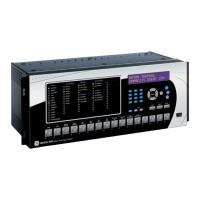GE Multilin M60 Motor Protection System 2-1
2 PRODUCT DESCRIPTION 2.1 INTRODUCTION
2
2 PRODUCT DESCRIPTION 2.1INTRODUCTION 2.1.1 OVERVIEW
The M60 Motor Protection System is a microprocessor based relay designed for the protection and management of
medium and large sized motors.
Overvoltage and undervoltage protection, thermal overload, fault diagnostics, and RTU functions are provided. The M60
provides phase, neutral, ground and negative sequence, instantaneous and time overcurrent protection. The time overcur-
rent function provides multiple curve shapes or FlexCurve™ for optimum co-ordination.
The relay also features an enhanced thermal model with custom curves, current unbalance biasing, and running and
stopped exponential cooling curves. An optional RTD module allows for the thermal model RTD bias function. Motor start
and supervision functions include starts per hour, time between starts, restart time, acceleration time, emergency restart,
and start inhibit. Sensitive directional power, mechanical jam, and current unbalance elements are also included as stan-
dard functions. Additional functions that are not part of the standard M60 element set can be easily configured and imple-
mented using the FlexElement™ and FlexLogic™ functionality.
Voltage, current, and power metering is built into the relay as a standard feature. Current parameters are available as total
waveform RMS magnitude, or as fundamental frequency only RMS magnitude and angle (phasor).
Diagnostic features include an event recorder capable of storing 1024 time-tagged events, oscillography capable of storing
up to 64 records with programmable trigger, content and sampling rate, and data logger acquisition of up to 16 channels,
with programmable content and sampling rate. The internal clock used for time-tagging can be synchronized with an IRIG-
B signal or via the SNTP protocol over the Ethernet port. This precise time stamping allows the sequence of events to be
determined throughout the system. Events can also be programmed (via FlexLogic equations) to trigger oscillography data
capture which may be set to record the measured parameters before and after the event for viewing on a personal com-
puter (PC). These tools significantly reduce troubleshooting time and simplify report generation in the event of a system
fault.
Several options are available for communication. A faceplate RS232 port can be used to connect to a computer for the pro-
gramming of settings and the monitoring of actual values. The RS232 port has a fixed baud rate of 19.2 kbps. The rear
RS485 port allows independent access by operating and engineering staff. It can be connected to system computers with
baud rates up to 115.2 kbps. All serial ports use the Modbus RTU protocol. The IEC 60870-5-103 protocol is supported on
the RS485 interface. IEC 60870-5-103, DNP, and Modbus cannot be enabled simultaneously on this interface. Also only
one of the DNP, IEC 60870-5-103, and IEC 60870-5-104 protocols can be enabled at any time on the relay. When the IEC
60870-5-103 protocol is chosen, the RS485 port has a fixed even parity and the baud rate can be either 9.6 kbps or 19.2
kbps. The 100Base-FX Ethernet interface provides fast, reliable communications in noisy environments. The Ethernet port
supports IEC 61850, Modbus/TCP, and TFTP protocols, PTP (according to IEEE Std. 1588-2008 or IEC 61588), and allows
access to the relay via any standard web browser (M60 web pages). The IEC 60870-5-104 protocol is supported on the
Ethernet port. DNP and IEC 60870-5-104 cannot be enabled at the same time. The Ethernet port also supports the Parallel
Redundancy Protocol (PRP) of IEC 62439-3 (clause 4, 2012) when purchased as a CPU module option.
The M60 IEDs use flash memory technology which allows field upgrading as new features are added. The following Single
line diagram illustrates the relay functionality using ANSI (American National Standards Institute) device numbers.
Table 2–1: DEVICE NUMBERS AND FUNCTIONS
DEVICE
NUMBER
FUNCTION DEVICE
NUMBER
FUNCTION
27P Phase Undervoltage 51G Ground Time Overcurrent
27X Auxiliary Undervoltage 59N Neutral Overvoltage
32 Sensitive Directional Power 59P Phase Overvoltage
37 Undercurrent 59X Auxiliary Overvoltage
37P Underpower 59_2 Negative Sequence Overvoltage
46 Current Unbalance 66 Starts Per Hour, Time Between Starts
47 Phase Sequence Voltage 67N Neutral Directional Overcurrent
49 Thermal Overload 67P Phase Directional Overcurrent
50BF Breaker Failure 81O Overfrequency
50G Ground Instantaneous Overcurrent 81U Underfrequency
50N Neutral Instantaneous Overcurrent 87S Stator Differential
50P Phase Instantaneous Overcurrent --- Mechanical Jam

